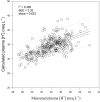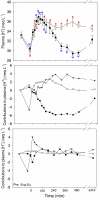The effect of oral sodium acetate administration on plasma acetate concentration and acid-base state in horses
- PMID: 18096070
- PMCID: PMC2241837
- DOI: 10.1186/1751-0147-49-38
The effect of oral sodium acetate administration on plasma acetate concentration and acid-base state in horses
Abstract
Aim: Sodium acetate (NaAcetate) has received some attention as an alkalinizing agent and possible alternative energy source for the horse, however the effects of oral administration remain largely unknown. The present study used the physicochemical approach to characterize the changes in acid-base status occurring after oral NaAcetate/acetic acid (NAA) administration in horses.
Methods: Jugular venous blood was sampled from 9 exercise-conditioned horses on 2 separate occasions, at rest and for 24 h following a competition exercise test (CET) designed to simulate the speed and endurance test of 3-day event. Immediately after the CETs horses were allowed water ad libitum and either: 1) 8 L of a hypertonic NaAcetate/acetic acid solution via nasogastric tube followed by a typical hay/grain meal (NAA trial); or 2) a hay/grain meal alone (Control trial).
Results: Oral NAA resulted in a profound plasma alkalosis marked by decreased plasma [H+] and increased plasma [TCO2] and [HCO3-] compared to Control. The primary contributor to the plasma alkalosis was an increased [SID], as a result of increased plasma [Na+] and decreased plasma [Cl-]. An increased [Atot], due to increased [PP] and a sustained increase in plasma [acetate], contributed a minor acidifying effect.
Conclusion: It is concluded that oral NaAcetate could be used as both an alkalinizing agent and an alternative energy source in the horse.
Figures








Similar articles
-
Oral acetate supplementation after prolonged moderate intensity exercise enhances early muscle glycogen resynthesis in horses.Exp Physiol. 2009 Aug;94(8):888-98. doi: 10.1113/expphysiol.2009.047068. Epub 2009 May 8. Exp Physiol. 2009. PMID: 19429643
-
Effect of sodium bicarbonate administration on metabolic responses to maximal exercise.Equine Vet J Suppl. 2002 Sep;(34):539-44. doi: 10.1111/j.2042-3306.2002.tb05479.x. Equine Vet J Suppl. 2002. PMID: 12405747 Clinical Trial.
-
Fluid and electrolyte supplementation after prolonged moderate-intensity exercise enhances muscle glycogen resynthesis in Standardbred horses.J Appl Physiol (1985). 2009 Jan;106(1):91-100. doi: 10.1152/japplphysiol.90783.2008. Epub 2008 Oct 23. J Appl Physiol (1985). 2009. PMID: 18948447
-
Fluid, electrolyte, and acid-base balances in three-day, combined-training horses.Vet Clin North Am Equine Pract. 1998 Apr;14(1):137-45. doi: 10.1016/s0749-0739(17)30216-x. Vet Clin North Am Equine Pract. 1998. PMID: 9561692 Review.
-
Sodium bicarbonate loading and the rules of racing.Br Vet J. 1995 Sep-Oct;151(5):473-5. doi: 10.1016/s0007-1935(05)80021-1. Br Vet J. 1995. PMID: 8556310 Review. No abstract available.
Cited by
-
Treatment of experimental hyperchloremic metabolic acidosis in horses with enteral electrolyte solution containing sodium acetate.Front Vet Sci. 2024 Sep 11;11:1376578. doi: 10.3389/fvets.2024.1376578. eCollection 2024. Front Vet Sci. 2024. PMID: 39323875 Free PMC article.
-
Physicochemical Analysis of Mixed Venous and Arterial Blood Acid-Base State in Horses at Core Temperature during and after Moderate-Intensity Exercise.Animals (Basel). 2022 Jul 22;12(15):1875. doi: 10.3390/ani12151875. Animals (Basel). 2022. PMID: 35892525 Free PMC article.
References
-
- Schott HC, Hinchcliff KW. Fluids electrolytes and bicarbonate. In: Hinchcliff KW, Sams RA, editor. Vet Clin North Am: equine practice – drug use in performance horses. Philadelphia: WB Saunders; 1993. pp. 577–604. - PubMed
-
- Heigenhauser GJ, Jones NL. Bicarbonate loading. In: Lamb DR, Williams MH, editor. Perspectives in exercise science and sports medicine, Ergogenics – enhancement of performance exercise and sport. Vol. 4. Dubuque, IA: Brown and Benchmark; 1991. pp. 183–221.
-
- Lloyd DR, Rose RJ. Effects of several alkalinizing agents on acid-base balance in horses. Proceedings of the 11th International Conference of Racing Analysts and Veterinarians. 1996. pp. 104–110.
-
- Kline K, Frey LP, Foreman JH, Lyman JT. Effects of intravenous sodium bicarbonate and sodium acetate on equine acid-base status. J Eq Vet Sci. 2005;25:349–354. doi: 10.1016/j.jevs.2005.07.003. - DOI
-
- Stewart PA. Modern quantitative acid-base chemistry. Can J Physiol Pharmacol. 1983;61:1441–1461. - PubMed
Publication types
MeSH terms
Substances
LinkOut - more resources
Full Text Sources
Medical
Miscellaneous

